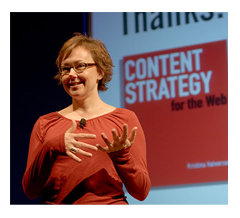If it seems like a whole lot of the smart folks you know in the Content space are out of the country right now, you might check #CSforum10 on twitter to see where they are. Today marks the start of the first "Content Strategy Forum" and the emergence of the Content Strategist key new character on the media stage.
How did this happen? What does it mean?
The first time I noticed the word "Content" had changed, I was being ushered into the inner sanctum of Zappos by a woman answering phones in an Elvis costume. Why is there a content department at Zappos? Don't they sell shoes and other nifty stuff? Well, it turns out, at Zappos the folks who make images, text, and product information for the Web site are working with Zappos "Content." Makes sense, in a Zappos kind of way, I thought at the time.
department at Zappos? Don't they sell shoes and other nifty stuff? Well, it turns out, at Zappos the folks who make images, text, and product information for the Web site are working with Zappos "Content." Makes sense, in a Zappos kind of way, I thought at the time.
But in the eight months since that visit, the world has changed. All of us, it now appears, are in the Content business. Retail, E-commerce, Consumer Brands. And Media. It's all content now. And, if you accept that fact that your company is in the Content Business, then you're going to need a plan to turn your "build-it-and-forget-it" Web site into a thriving and organic content publishing offering.
That's where the pros come in.
You may not have heard of them yet, but you will. They're called Content Strategists, and they're fast becoming the most in-demand advisers for Web sites and corporate customers looking for a way to evolve into content makers and curators.
Kristina Halvorson, who spoke to a packed house at this years South By Southwest (SXSW)  explains it this way: "We, the people who make Web sites, have been talking for 15 years about user experience, information architecture, content management systems, coding, metadata, visual design, user research, and all the other disciplines that facilitate our users' abilities to find and consume content."
explains it this way: "We, the people who make Web sites, have been talking for 15 years about user experience, information architecture, content management systems, coding, metadata, visual design, user research, and all the other disciplines that facilitate our users' abilities to find and consume content."
But, as she points out, it appears we've been missing the point: "We haven't been talking about the meat of the matter. We haven't been talking about the content itself."
Halvorson wrote the book: Content Strategy for the Web and says that today anyone with a Web presence who's not thinking about their content strategy is missing the point of Web publishing:
She suggests some key points needed in defining a content strategy:
- Content purpose (i.e., how content will bridge the space between audience needs and business requirements)
- Content gap analysis
- Metadata frameworks and related content attributes
- Search engine optimization (SEO)
The idea is simple, content isn't the thing the copywriter does at the end of the design and development phase of Web site development, it is the output of your site, fresh and evolving every day in a conversation with your visitors and your customers and your partners.
The danger, as Jeffrey MacIntyre puts it, is that your site develops a terrible disease: "...what we call 'rot' or redundant, outdated or trivial content because, again, you're expected to reflect your activities as an organization on the Web, particularly on your Web presence."

Filter or be flooded.
MacIntyre is a consultant who works with brands, sites, and publishers to manage the overwhelming content flood, and keep consumers from drowning in a sea of data. "A lot of the clients I work with manage an enormous fire-hose. Which is to say they have a huge standing inventory of content and they are also creating a huge volume of content on a daily basis" explains MacIntyre.
"I'm not just talking about article pages, or Twitter accounts, this is the whole Megillah, everything they're doing to communicate internally and externally."
Once companies recognize that every piece of data they create; news, PR, how-to info, Twitter feeds, needs to fit into a context framework, then they're ready for an "intervention" of sorts.
MacIntyre explains: "the Web site is a collective undertaking, part of a bigger enterprise. What a Content Strategist will do is a create a framework for how these decisions are going to be made."
"REALLY, they want the filter on the fire-hose because their users are demanding it. They don't want the whole fire-hose, because that's Google...we're dealing with a search driven content universe now."
The power of the realization that we're all content producers is that collectively it levels the playing field. While in "olden days" big companies were able to control production and distribution pipelines and service customers poorly. Today data roams freely, and the companies that can organize, filter, and publish data with speed, clarity, and accuracy are poised to take the lead over larger slower moving competitors.
"This is a publishing centric idea," says MacIntyre. "You need to produce content over time. You also need a process. You need a workflow. You need to have people that are well trained. You need an organizational intervention. The first checkbox is reading the room to see how is the organization aligned today. How can they be effective to solve these problems."
Publishing - do you Publish with Passion?
As you dig into the Content Strategist world, you see that there's a theme that develops. Once you get outside of conventional content makers (newspapers, magazines, books, etc.) the role of content is pushed down in organizations to copy writers who often have little say, little time, and little respect.
But in the new world of content absorbing PR, Marketing, CRM functions, media relations, support, corporate and investor relations, Content comes out of the back room and moves to the front page--content is the "face" of the always-on corporation. So, Content Strategy takes on a mission critical role for all public functions.
Back to Kristina Halvorson, who evangelizing the "taking content seriously" meme that is on the rise, she says: "Treat Content like a critical business asset. It is one."
And finally, be aware of the cost to your brand and your organization of not treating Content as a core asset. Says Halvorson, if you treat Content as an 11th-hour issue, you'll have bad content, unhappy employees, disappointed users, and budget overages. Ouch.
[Kristina Halvorson Photo by 42Jellos]
View all the videos related to this story on CurationNation.org
Steve Rosenbaum is The CEO of Magnify.net, a NYC-based Web platform that powers content aggregation and curation. He has been building and growing consumer-content businesses since 1992. He was the creator and Executive Producer of MTV UNfiltered, a series that was the first commercial application of user-generated video in commercial TV. He is a documentary director who's film Seven Days in September chronicled life in the week after 9/11 in New York.
Follow Steve on Twitter @Magnify
Originally published in Fastcompany.com.

